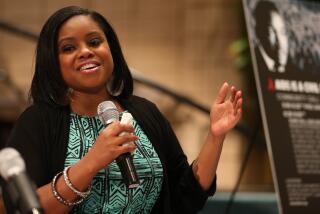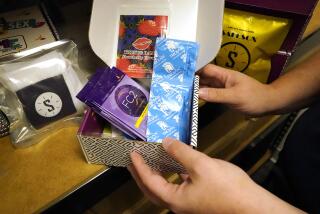Despite the specter of acquired immune deficiency syndrome--and all the public debate that has gone with it--most parents are embarrassed to talk with their children about sex, according to sex education professionals : A Parental Dilemma: Teaching Kids ‘Safe Sex’
- Share via
The subject is the birds and the bees--and AIDS. How do you tell it as it is to a child who may reach puberty as young as 9, and for whom irresponsible sexual behavior could prove not just heartbreaking, but fatal?
Despite the specter of acquired immune deficiency syndrome--and all the public discussion that has gone with it--most parents still find it “too embarrassing” to talk about sex with their children, according to sex education professionals.
But talk they must, the experts say, if children are to understand sex and the new hazards that come with it in the 1980s.
The Times asked several sex educators how parents can overcome both discomfort and alarm in communicating all-important information about “safe sex” to their youngsters.
In their replies, a key word that emerged was responsibility . According to the experts, it has never been more urgent that young people--both boys and girls--be taught to accept responsibility for their sexual health and conduct.
A Dual Responsibility
“Decades of fathers told their sons to use condoms and then, post-Pill, the girl was responsible for preventing pregnancy,” said Carol Cassell, an Albuquerque-based community health educator. “Well, we need to say to our sons, ‘If you have sex, you have to protect yourself and her. If she says not to worry, you worry anyway.’ ”
Ellen Wagman, director of training for Santa Cruz-based ETR Associates, which develops sex education materials for young people, said, “You need to be quite honest with them” about sex and AIDS and at the same time emphasize “there are some real good ways you can avoid becoming infected.
“The first, of course, is abstaining. The second is by making sure you use condoms all the time. The third is making sure that you know your partner extremely well and communicate your sexual histories.”
Some further advice from the professionals on talking to children about sex and AIDS:
- When should I start? “I would take the clues from my kids,” Wagman said. “It may be that younger children are going to be asking you questions, but I would think probably no earlier than 9. If there’s a child in school who has AIDS, there may be many more questions.”
Sex education in the broadest context--teaching a child positive attitudes about the body--can begin “as soon as you get home from the hospital,” according to Indiana University health sciences professor William L. Yarber. Yarber, who has developed sex education curricula in use in secondary schools throughout the country, believes children should grow up understanding “responsibility for one’s own health, and the health of a (sex) partner, whether you’re a male or female.”
Mary Lee Tatum, a teacher and consultant on family life and sex education in Falls Church, Va., thinks AIDS education can start in third or fourth grade, “when one begins to talk about menstruation and the way we feel ‘tingly’ because of hormones. Then one needs to say that sometimes, when people are involved intimately with other people, disease can be spread.”
- How explicit should I be? Yarber said it isn’t necessary to be too sexually explicit with very young children, who may feel anxiety about AIDS long before they can really understand what the disease is. He suggested telling them that “AIDS is a disease that causes some adults to die, but less commonly affects children. AIDS is very hard to get.”
“A first-grader does not need to understand the intimacies of vaginal intercourse in order to understand AIDS,” concurred Pat Christen, a former high school biology teacher who is media relations coordinator for the San Francisco AIDS Foundation. Rather than focusing on sexual contact, she suggested, the explainer might point out that “there is no need to be afraid of people with AIDS” unless there is an exchange of blood.
Junior-high age, she believes, “may be the proper time to make the connection” between sexual activity and AIDS.
- Breaking the ice. Wagman suggests looking for a “teachable moment,” perhaps after watching a TV program, because there’s so much media discussion of sex.
Cassell recommends parents use family events to broach the human side of sex without embarrassment. “You talk to your kids as they’re growing up--’Did you notice that aunt so-and-so is going to have a baby?’ ” she said. “Don’t just look at your kids and say, ‘Puberty! Aha! I’ll go get the slide show.’ ”
Remember, too, that sex education isn’t a one-shot affair “like an inoculation,” said James Maddock, president of the American Assn. of Sex Educators, Counselors and Therapists. When a 9-year-old asks a question, Maddock said, the response all too often is: “Gee, we covered that when we got out the book when you were 5.”
- Schools can help . Many sex educators believe that school, not home, is the appropriate place for detailed AIDS education because few parents are fully educated about the disease.
Classroom discussion can also make dating-age youngsters more confident about enforcing safe-sex rules, by assuring them that peers are hearing the same vital messages.
“Not all teen-agers are having sex, and they need to hear that not from an adult but from each other,” explained Tatum. She added that the classroom can be ideal for delivering some bluntly pragmatic lessons. Tatum, for instance, tells junior high and high school youngsters: “If someone presses you to forget about a condom, and let’s have sex anyhow, there are two things you know--they don’t care about their own health, or yours.”
- Avoid scare tactics. They can cause psychological damage, and, most likely, they just don’t work. The potential trap in discussing AIDS, said Maddock, a University of Minnesota professor, is that parents and others will “select out all the scary parts, highlight those for young people and assume in some way that will stop them from being sexual. It’s never happened before and I’m not sure even something as deadly as AIDS would make that approach work now,” he said.
In his view, one possible result could be “neurotic and overblown anxiety” over the whole subject of sexuality. After all, “What could be more scary than the idea of dying?”
Wagman agreed. Before explaining to children that “there are some problems” associated with sex, she suggested, it is important to talk about sexual intercourse in the context of “relating to people of the other sex, the source of pleasure you can have from your body.”
- Emphasize values without preaching. Discussions of sexual health quickly evolve into moral discussions--and parents may have to shoulder a heavier burden than educators on that front.
Maddock explained: “Educational material can say that abstinence is the best protection; that’s scientifically right. The second best is fidelity; that’s true. But you can also say something like persons involved in a long-term relationship (married or not, homosexual or heterosexual) with a non-infected partner have less risk.”
In seminars for fifth- and sixth-graders, Cassell said she is careful to talk about the difference between sex and love. “Love,” she said, “is a special chemistry, something that takes time and compromise. Sex is a feeling and a desire. Love is a relationship.”
Tatum emphasized that the “least effective” way of teaching about sex and its risks is “telling kids what to do. . . . (They) need to talk it through, to look at the consequences, to hear each other talk.”
Christen, the San Francisco AIDS foundation official, concurred. “Teen-agers don’t need adults’ permission to have sex. You can’t put them on one of those toddler leashes,” she said. More effective, she suggested, is to set guidelines, talk about commitment and “safe sex,” and “hope they’ll use good judgment.”
AIDS IN THE UNITED STATES
Methods of transmission and numbers of AIDS cases in U.S.
1987 1986 1985 Sexually, among gay or bisexual men 23,322 15,227 7,633 Sexually or by intraveneous drug abuse among gay men * 2,691 -- -- By intravenous drug use 5,902 3,571 1,791 Due to hemophilia/coagulation disorder 327 162 69 Sexually, among heterosexuals 714 308 94 By transfusions of blood and blood components 716 339 144 Undertermined 1,805 1,164 682 Totals 35,477 20,771 10,413 Cases among persons 13 through 19 years old, inclusive. 145 86 57
* New category in 1987. Previously included with gay or bisexual men.
Except where otherwise noted, numbers refer to AIDS victims age 13 through adult. All numbers apply to the last Monday in May on the year indicated.
Source: AIDS Weekly Surveillance Report; AIDS Program, Centers for Infectious Diseases, Atlanta.
More to Read
Sign up for Essential California
The most important California stories and recommendations in your inbox every morning.
You may occasionally receive promotional content from the Los Angeles Times.













